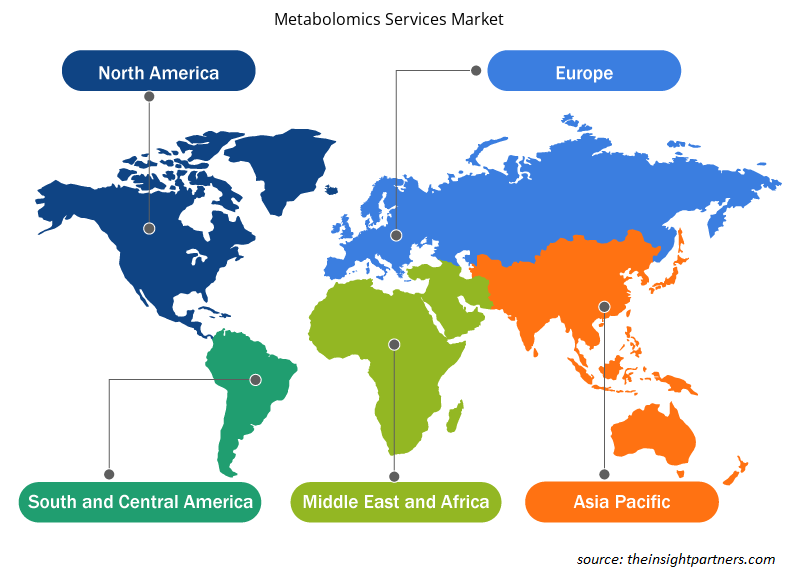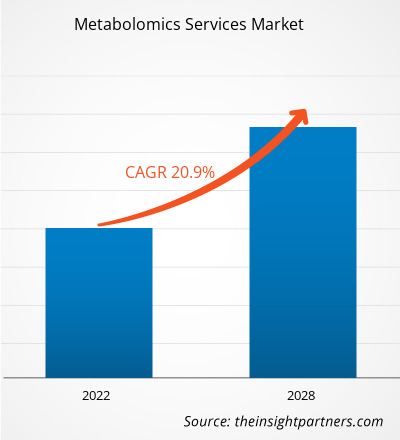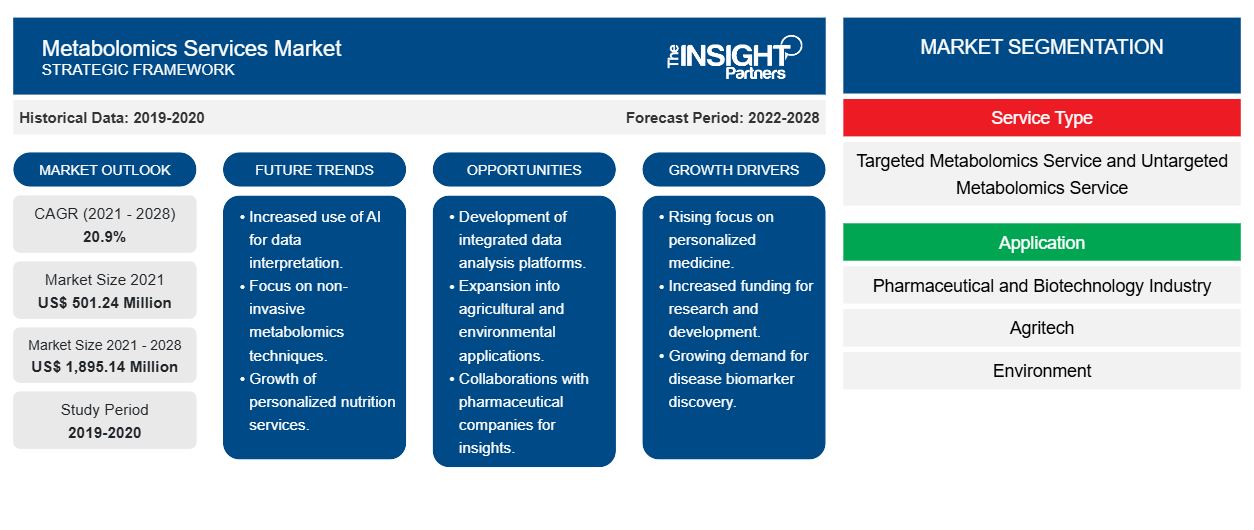[Informe de investigación] Se espera que el mercado de servicios de metabolómica alcance los US$ 1.895,14 millones para 2028 desde los US$ 501,24 millones en 2021; se estima que crecerá a una CAGR del 20,9% entre 2021 y 2028.
La metabolómica es el estudio y análisis de los procesos biológicos que involucran intermediarios y subproductos metabólicos: los metabolomas. Los metabolomas incluyen metabolitos secundarios, moléculas de señalización, hormonas e intermediarios metabólicos.
El informe ofrece un análisis profundo del mercado de servicios de metabolómica , haciendo hincapié en las tendencias del mercado, los avances tecnológicos, la dinámica del mercado y el panorama competitivo (que involucra a los principales actores del mercado en todo el mundo). También incluye el impacto de la pandemia de COVID-19 en el mercado en todas las regiones principales. América del Norte tiene la mayor participación de mercado, y el crecimiento del mercado en esta región se atribuye a una alta conciencia y aceptación de los servicios de metabolómica, un número cada vez mayor de minoristas en línea y un número cada vez mayor de innovaciones y lanzamientos de productos. Además, es probable que el creciente gasto de las empresas de tecnología sexual también tenga un impacto positivo en el mercado de servicios de metabolómica de América del Norte durante el período de pronóstico. El mercado, por región, está segmentado en América del Norte, Europa, Asia Pacífico (APAC), Medio Oriente y África (MEA) y América del Sur y Central (SAM).
Personalice este informe según sus necesidades
Obtendrá personalización en cualquier informe, sin cargo, incluidas partes de este informe o análisis a nivel de país, paquete de datos de Excel, así como también grandes ofertas y descuentos para empresas emergentes y universidades.
- Obtenga las principales tendencias clave del mercado de este informe.Esta muestra GRATUITA incluirá análisis de datos, desde tendencias del mercado hasta estimaciones y pronósticos.
Perspectivas del mercado
La creciente incidencia del cáncer impulsa el crecimiento del mercado de servicios de metabolómica
La metabolómica es una de las tecnologías en crecimiento y robustas para detectar una amplia gama de metabolitos en tejidos y biofluidos. Este proceso tiene una aplicación importante en el análisis y los estudios asociados con la enfermedad del cáncer. Se espera que la creciente prevalencia de diferentes tipos de cáncer impulse el mercado durante el período de pronóstico. El diagnóstico del cáncer juega un papel esencial en el tratamiento del cáncer. Según los datos publicados por la Organización Mundial de la Salud (OMS) en septiembre de 2021, casi el 70% de las muertes por cáncer se notificaron en países de ingresos bajos y medios de todo el mundo. La participación mundial total de la incidencia del cáncer según los registros del Observatorio Mundial del Cáncer es mama (2,26 millones de casos 11,7%), pulmón (2,21 millones de casos 11,4%), colon y recto (1,93 millones de casos 10%), próstata (1,41 millones de casos 7,3%), estómago (1,09 millones de casos 5,6%). A continuación, se muestran los detalles sobre la prevalencia regional en 2020:
- Esta muestra GRATUITA incluirá análisis de datos, desde tendencias del mercado hasta estimaciones y pronósticos.
Información basada en el tipo de servicio
El mercado de servicios de metabolómica, según el tipo de servicio, se ha segmentado en servicios de metabolómica dirigida y servicios de metabolómica no dirigida. Es probable que el segmento de servicios de metabolómica dirigida tenga una mayor participación de mercado en 2021. Además, se prevé que el segmento de servicios de metabolómica dirigida registre una CAGR más alta en el mercado durante el período de pronóstico.
Perspectivas basadas en aplicaciones
El mercado de servicios de metabolómica, según su aplicación, está segmentado en la industria farmacéutica y biotecnológica, la tecnología agrícola y el medio ambiente. Es probable que el segmento de la industria farmacéutica y biotecnológica tenga la mayor participación del mercado en 2021. Además, se espera que el mercado de este segmento crezca a la tasa compuesta anual más rápida del 21,6 % durante el período 2021-2028.
Los actores del mercado de servicios de metabolómica adoptan estrategias orgánicas como el lanzamiento y la expansión de productos para expandir su presencia global y su cartera de productos.
Perspectivas regionales del mercado de servicios de metabolómica
Los analistas de Insight Partners explicaron en detalle las tendencias y los factores regionales que influyen en el mercado de servicios de metabolómica durante el período de pronóstico. Esta sección también analiza los segmentos y la geografía del mercado de servicios de metabolómica en América del Norte, Europa, Asia Pacífico, Oriente Medio y África, y América del Sur y Central.

- Obtenga datos regionales específicos para el mercado de servicios de metabolómica
Alcance del informe de mercado de servicios de metabolómica
| Atributo del informe | Detalles |
|---|---|
| Tamaño del mercado en 2021 | US$ 501,24 millones |
| Tamaño del mercado en 2028 | US$ 1.895,14 millones |
| CAGR global (2021-2028) | 20,9% |
| Datos históricos | 2019-2020 |
| Período de pronóstico | 2022-2028 |
| Segmentos cubiertos | Por tipo de servicio
|
| Regiones y países cubiertos | América del norte
|
| Líderes del mercado y perfiles de empresas clave |
|
Densidad de actores del mercado: comprensión de su impacto en la dinámica empresarial
El mercado de servicios de metabolómica está creciendo rápidamente, impulsado por la creciente demanda de los usuarios finales debido a factores como la evolución de las preferencias de los consumidores, los avances tecnológicos y una mayor conciencia de los beneficios del producto. A medida que aumenta la demanda, las empresas amplían sus ofertas, innovan para satisfacer las necesidades de los consumidores y aprovechan las tendencias emergentes, lo que impulsa aún más el crecimiento del mercado.
La densidad de actores del mercado se refiere a la distribución de las empresas o firmas que operan dentro de un mercado o industria en particular. Indica cuántos competidores (actores del mercado) están presentes en un espacio de mercado determinado en relación con su tamaño o valor total de mercado.
Las principales empresas que operan en el mercado de servicios de metabolómica son:
- BASF SE
- TMIC
- Proteómica creativa
- BGI
- RTI Internacional
Descargo de responsabilidad : Las empresas enumeradas anteriormente no están clasificadas en ningún orden particular.

- Obtenga una descripción general de los principales actores clave del mercado de servicios de metabolómica
Por tipo de servicio
- Servicio de metabolómica dirigida
- Servicio de metabolómica no dirigida
Por aplicación
- Industria farmacéutica y biotecnológica
- Descubrimiento de biomarcadores
- Descubrimiento de fármacos
- Pruebas toxicológicas
- Otros
- Tecnología agrícola
- Ambiente
Por
Geografía
América del norte
- A NOSOTROS
- Canadá
- México
Europa
- Francia
- Alemania
- Italia
- Reino Unido
- España
- Resto de Europa
Asia Pacífico (APAC)
- Porcelana
- India
- Corea del Sur
- Japón
- Australia
- Resto de APAC
Oriente Medio y África (MEA)
- Sudáfrica
- Arabia Saudita
- Emiratos Árabes Unidos
- Resto de MEA
América del Sur y Central (SCAM)
- Brasil
- Argentina
- Resto de estafa
Perfiles de empresas
- BASF SE
- TMIC
- Proteómica creativa
- BGI
- RTI Internacional
- Tecnologías Afekta Ltd.
- Centro de investigación del cáncer Fred Hutchinson
- Centro de metabolómica de la costa oeste
- Tu Molecular
- Metabolon, Inc.
- biocrates ciencias biológicas ag
- Chenomx Inc.
- CAMPAMENTO C
- metaSysX
- MS-Ómica
- Análisis histórico (2 años), año base, pronóstico (7 años) con CAGR
- Análisis PEST y FODA
- Tamaño del mercado, valor/volumen: global, regional y nacional
- Industria y panorama competitivo
- Conjunto de datos de Excel
Informes recientes
Testimonios
Razón para comprar
- Toma de decisiones informada
- Comprensión de la dinámica del mercado
- Análisis competitivo
- Información sobre clientes
- Pronósticos del mercado
- Mitigación de riesgos
- Planificación estratégica
- Justificación de la inversión
- Identificación de mercados emergentes
- Mejora de las estrategias de marketing
- Impulso de la eficiencia operativa
- Alineación con las tendencias regulatorias





















 Obtenga una muestra gratuita para - Mercado de servicios de metabolómica
Obtenga una muestra gratuita para - Mercado de servicios de metabolómica